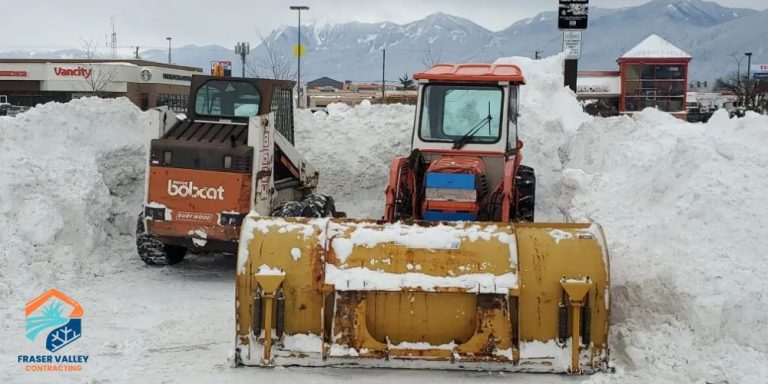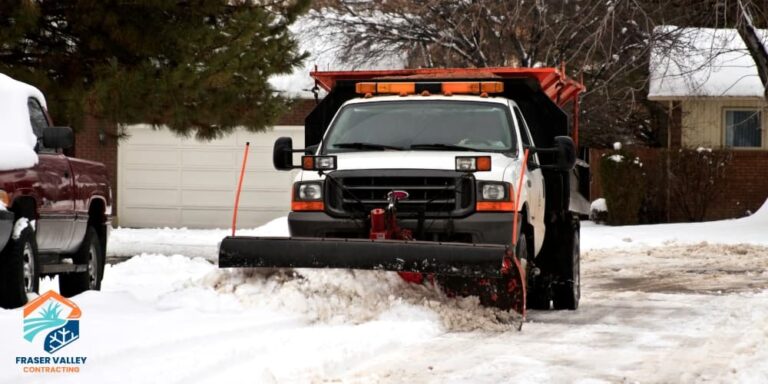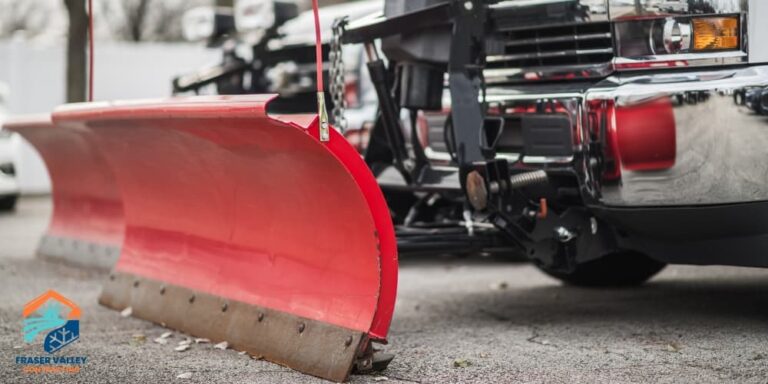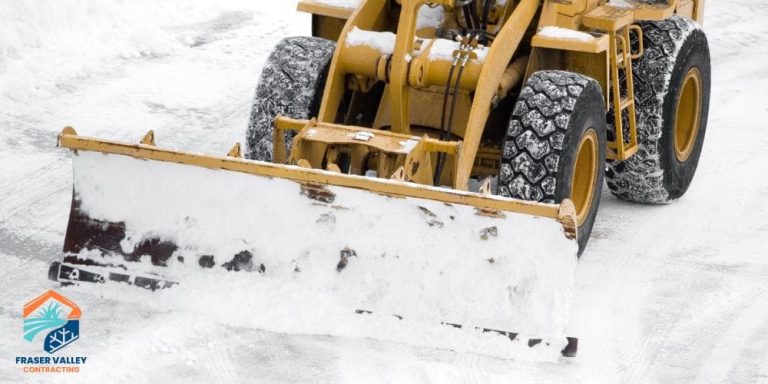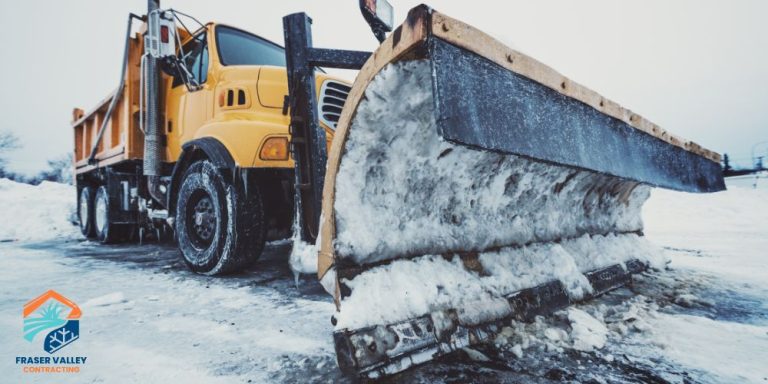Chilliwack averages about 85 cm of snow a year, with most accumulation in December and January. The wet, coastal climate means frequent freeze–thaw and ice after rain or melting events.
Workplace risk rises in winter. WorkSafeBC reports an 11% increase in slip, trip, and fall injuries from November to March. Proper snow and ice controls are not just “nice to have.” They reduce claims and downtime.
The City of Chilliwack requires adjacent sidewalks to be cleared by noon the day after a snowfall. If your frontage is non-compliant, you risk fines and liability exposure.
Pre-season checklist (finish before first forecasted event)
1) Walk the site and map priorities
- Mark fire lanes, loading docks, main entrances, accessible routes, and pedestrian desire lines.
- Pre-assign snow storage areas away from drains, hydrants, visibility triangles, and pedestrian paths.
- Stake curbs, islands, dock edges, utility covers, and speed bumps with tall flexible markers.
A sample layout is shown below. Notice how priority lanes, drains, and storage piles are identified ahead of time to keep operations smooth during snow events.

2) Define your Level of Service (LOS)
- Triggers: plow at 3–5 cm, de-ice at forecast refreeze or black ice.
- Time targets: priority routes open before shift changes; full lot by opening.
- Communication: who approves extra pushes, who receives event logs, who signs off on closure of unsafe zones.
3) Select materials with the environment in mind
- Use liquid brine pretreatment when temps allow to reduce bond and speed cleanup.
- Choose de-icers by temperature range and surface sensitivity. Follow ECCC’s Road Salt Code of Practice and TAC best practices to cut usage and runoff without sacrificing safety.
4) Stage and service equipment
- Calibrate spreaders and sprayers. Service plows, loaders, skid steers.
- Pre-plan equipment paths that avoid bottlenecks and conflict with night operations.
5) Train staff and contractors
- Refresh slip-fall prevention and incident response.
- Make sure crews know storage zones, LOS targets, and reporting format.
6) Document everything
- Keep an event log: conditions, timestamps, passes, product types and rates, photos. These records matter if a claim arises.
In-season playbook
Before a storm
- Pretreat priority surfaces with brine to prevent bonding and reduce post-storm salt needs.
- Cone off no-park corridors for plow paths. Notify tenants of restrictions.
During a storm
- Keep priority lanes open first. Do not bury drains or accessible stalls with windrows.
- Push to designated piles that do not block sightlines or entrances.
After a storm
- Open catch basins and channel meltwater to drains to avoid refreeze.
- Treat shade zones, ramps, dock lips, and high-friction turns for black ice.
- Update the log with what was done and any hazards found.
Frontage compliance
- Clear sidewalks by noon the day after snowfall to meet the local bylaw. Coordinate timing with your contractor.
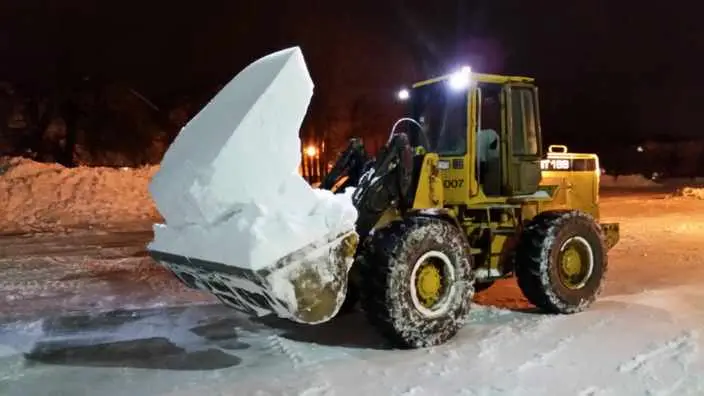
Fleet and access notes for Chilliwack
- Winter tires or chains are required on most B.C. highways from Oct 1–Apr 30. This can affect deliveries and staff access.
- Hillside roads in the city may have additional winter restrictions posted during events. Plan alternate routes for heavy equipment.
Budget and contracting
Pricing models you will see
- Per visit: predictable per event, volatile in heavy winters.
- Seasonal flat rate: budget certainty, priority response.
- Depth-based tiers: costs scale with severity.
What drives cost
- Acreage and pavement complexity, entrances and choke points, sidewalk frontage, snow-storage constraints, and de-icer mix.
- Material prices and storm frequency. Expect higher spend in years with prolonged cold snaps.
Contract essentials
- Define LOS targets, response times, pretreat protocols, sidewalk duties, documentation, and indemnification.
- Require certificates of insurance and confirm equipment redundancy.
Safety and risk management
- Slip-fall incidents are a top category of claims in B.C., and they spike in winter—train, sign, cone, and document.
- Indoors: use quality entrance mats, drip trays, and frequent mopping during events to control tracked-in moisture.
Environmental stewardship that also saves money
- Brine pretreatment and calibrated application typically reduce total salt use while improving outcomes. Store salt under cover, keep piles away from storm inlets, and avoid over-application on new concrete and landscaped areas. Follow ECCC Code and TAC guidance.

Quick spec for busy FMs
- Trigger: plow at 3–5 cm; pretreat ahead of forecast freeze; spot-treat high-risk zones.
- Targets: priority lanes open before shift change; full lot before opening.
- Docs: timestamped logs and photos every event.
- Compliance: sidewalks cleared by noon next day.
If you manage a yard, plant, retail center, or strata with large common areas, don’t wait for the first storm to hit. Partner with Fraser Valley Contracting for reliable commercial snow removal in Chilliwack that keeps your property safe, compliant, and accessible all winter long.

